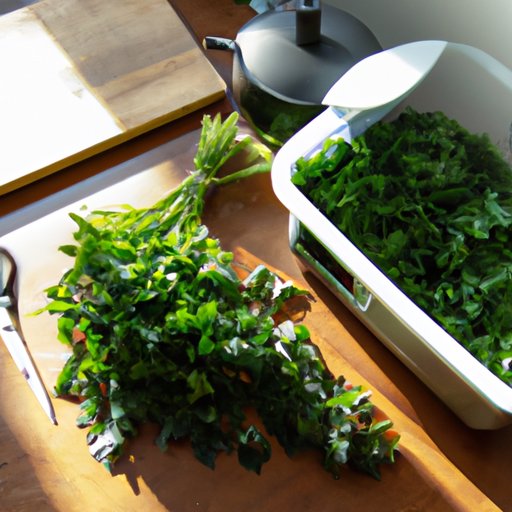
Introduction
Parsley is a flavorful herb that is commonly used in many dishes around the world. However, it is also an herb that tends to go to waste quickly. It can be difficult to use an entire bunch of parsley before it starts going bad, which is why many people wonder if they can freeze parsley for later use. In this article, we will explore the best methods for freezing parsley and how to preserve its freshness for longer.
Preserving the Freshness: A Complete Guide to Freezing Parsley
Freezing parsley is one of the easiest and most effective ways to preserve its freshness. The process is simple, and it helps to retain the flavor and nutritional value of the herb. Here is a step-by-step guide to freezing parsley:
1. Preparation
Wash the parsley thoroughly with water and pat it dry with a paper towel. Remove any damaged leaves or stems.
2. Freezing
There are two ways to freeze parsley: you can either freeze it whole or chop it up and freeze it in ice cube trays. To freeze parsley whole, simply place the washed and dried bunch of parsley into a freezer-safe bag or container. To freeze chopped parsley, chop it finely and place it into ice cube trays. Fill the trays with water and freeze them. Once the cubes have frozen, remove them from the trays and store them in a freezer-safe bag or container.
3. Storage
Store the frozen parsley in the freezer for up to six months. Label the container or bag with the date that you froze the parsley to ensure that you don’t keep it for too long.
Never Let Parsley Go to Waste: How to Properly Freeze Your Herbs
Freezing is just one of the many ways to preserve parsley. Other methods include drying, canning, and using salt. However, freezing is often considered the best method, as it helps to maintain the flavor of the herb. Here is a comparison of various methods for preserving parsley:
Drying: Drying parsley is a traditional method of preserving it. However, this method can cause the herb to lose its flavor and color.
Canning: Canning parsley involves canning it in vinegar or pickling it. This can be a good method if you want to preserve parsley for a long period. However, the pickling process can change the flavor of the herb.
Salt: Salting parsley involves layering chopped parsley with salt. This method can preserve the flavor of parsley for a long time, but it can also make it very salty.
When compared to these other methods, freezing is the most effective way to preserve the flavor of parsley while retaining its nutritional value.
Revitalize Your Recipes with Fresh Frozen Parsley: Tips and Tricks
Using frozen parsley in recipes is an excellent way to add flavor to your meals. Here are some tips for using frozen parsley in your recipes:
Soups and stews: Add frozen parsley directly to soups and stews. The parsley will thaw quickly and infuse the dish with flavor.
Sauces: When making sauces, add the frozen parsley during the last few minutes of cooking.
Salsas: Frozen diced parsley works well in salsas.
When using frozen parsley in recipes, be sure to adjust the cooking time and quantity to account for the water content from the ice cubes.
Maximizing the Shelf Life of Parsley: A Deep Dive into Freezing Techniques
Freezing is an effective method of preserving parsley, but it is important to understand how it can affect the herb. Here is a closer look at the science behind freezing and food preservation:
When food is frozen, the moisture inside the cells expands and causes the cells to burst. This can cause some herbs to lose their texture and flavor. However, parsley is a hardy herb that can withstand freezing. When parsley is frozen, its cellular structure changes, but its flavor and nutritional value are largely preserved.
To maximize the shelf life of parsley, it is important to freeze it as soon as possible after harvesting. The longer parsley is left out, the more it will degrade in quality. When freezing parsley, be sure to seal it in an airtight container or bag to prevent freezer burn, which can damage the flavor and texture of the herb.

From Garden to Freezer: Ensuring Longevity of Your Parsley Supply
If you want to ensure a steady supply of parsley for freezing, there are a few things you can do. First, plant parsley in your garden or in a pot. Parsley is easy to grow and can be harvested throughout the growing season.
When harvesting parsley, be sure to pick the leaves from the outside of the plant, as this will encourage new growth. Once you have harvested your parsley, wash it thoroughly and dry it before freezing.
It is also important to freeze parsley at the optimal time. Parsley is at its best just before it flowers. If you freeze parsley after it has flowered, it may lose some of its flavor and nutritional value.
Say Goodbye to Wasting Herbs: The Ultimate Guide to Freezing Parsley for Future Use
Freezing parsley is an excellent way to preserve its flavor and nutritional value for future use. By following the steps outlined in this article, you can ensure that your parsley stays fresh and tasty for up to six months. Be sure to label and date your frozen parsley to ensure that you use it before it goes bad. With these tips and tricks in mind, you’ll never have to waste parsley again!
Conclusion
Parsley is a versatile herb that can add flavor and nutrition to many dishes. However, it is also an herb that tends to go to waste quickly. Freezing parsley is a simple and effective way to preserve its freshness for future use. By following the steps outlined in this article, you can ensure that your parsley stays fresh and delicious for up to six months.





